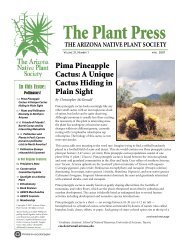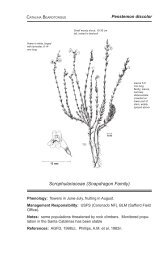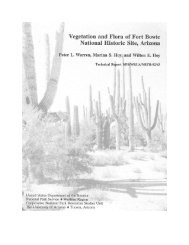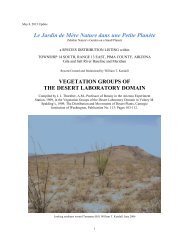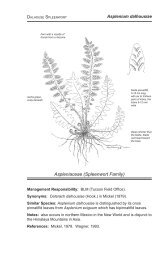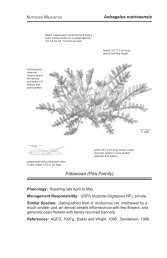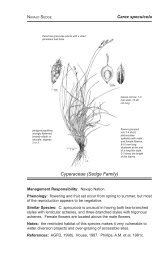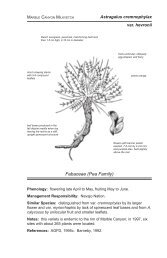color presentation), 68 (recorded as Echinochloa colonum (L.) Link), 77 (recorded as Echinochloa colonum (L.) Link), 85(110611 - color presentation of dried materials), 89 (reported under Miscellaneous Introduced Species as being a long-livedannual herb, also recorded as Echinochloa colona (L.) Link var. zonale (Guss.) Dewey), 101 (color photograph), 124 (110611),127, 140 (Page 299)*Echinochloa colona var. zonale (see footnote 89 under Echinochloa colona)Echinochloa colonum (see Echinochloa colona)Echinochloa crus-galli (C. Linnaeus) A.M. Palisot de Beauvois: BarnyardgrassCOMMON NAMES: Ankee Millet (Iowa); Arrocillo (Spanish); Barn Grass; Barn Yard Grass (a name also applied toother species); Barn-grass (a name also applied to other species); Barngrass (a name also applied to other species); BarnyardGrass (a name also applied to other species and the genus Echinochloa, Nebraska); Barnyard Millet (a name also applied to thegenus Echinochloa); Barnyard-grass (a name also applied to other species and the genus Echinochloa, Nebraska); Barnyardgrass(a name also applied to other species); Chicken Panic; Chicken Panic Grass; Chicken Panicgrass; Chicken-panic Grass; Chickenpanic-grass;Cock’s Foot (a name also applied to other species); Cock’s-foot (a name also applied to other species); Cock-spurBarnyard Grass; Cocks Foot Grass (a name also applied to other species); Cocks-foot Grass (a name also applied to otherspecies); Cock-spur Barnyard Grass; Cocksfoot Panicum; Cockspur (a name also applied to the genus Echinochloa); CockspurBarnyard Grass; Cockspur Grass (a name also applied to the genus Echinochloa); Cockspur-grass (a name also applied to thegenus Echinochloa); Common Barnyard Grass; Common Barnyard-grass; Common Barnyardgrass; Common Cockspur;Common Cockspur Grass; Crusgalli Barnyard Grass; Echinochloa Pied-de-coq (French); Gewöhnliche Hühnerhirse (German);Grama Morada (Hispanic); Hedgehog Grass; Hühnerhirse (German); Japanese Millet (a name also applied to other species);Large Barnyard Grass; Large Barnyard-grass; Large Barnyardgrass; Large Crowfoot Grass (New Mexico); Loose Panic Grass;Loose Panic-grass; Mexican Barnyard Grass; Pasto Alemán (Hispanic); Pasto Mijillo (Hispanic); Pata de Gallo (Spanish); Pie deGallina (Spanish); Pied-de-coq (French); Sanwak (India); Water Grass (a name also applied to other species); Water-grass (aname also applied to other species); Watergrass (a name also applied to other species); Zacate de Agua (Spanish); Zacate deCorral (Hispanic). DESCRIPTION: Terrestrial annual graminoid (spreading, decumbent and/or erect culms 4 to 83 inches inheight; one plant was described as being 4 feet in height an 40 inches in diameter at the base); the foliage may be gray-green oryellow-green; the leaves may have purple bands; flowering generally takes place between mid-May and early November;however, flowering year round has been reported (additional record: one for mid-December). HABITAT: Within the range ofthis species it has been reported from mountains; gravelly-sandy and sandy mesas; gravelly-sandy plateaus; bases of cliffs; rockyand gravelly-loamy canyons; rocky, rocky-sandy, sandy and loamy canyon bottoms; pockets of soil; bluffs; ridges; ridgetops;openings in woodlands; loamy meadows; escarpments; rocky, gravelly, sandy, sandy-clayey-loamy, loamy, clayey and clayeyloamyslopes; amongst cobbles; gravelly-sandy plains; gravelly, gravelly-loamy and sandy flats; uplands; hollows; valley floors;coastal plains; along gravelly and sandy-loamy roadbeds; along gravelly, gravelly-loamy, gravelly-clayey-loamy, sandy andsandy-loamy roadsides; arroyos; along draws; gulches; gullies; bottoms of gullies; ravines; sandy and clayey seeps; springs;along and in sandy streams; along and in rocky-sandy and sandy streambeds; along creeks; within rocky creekbeds; along and inrivers; in cobbly-sandy and sandy riverbeds; along and in rocky and sandy washes; within drainages; poolbeds; along and inponds; muddy pondbeds; along lakes; clayey lakebeds; bogs; ciénegas; clayey freshwater marshes; swamps; clayey-muddydepressions; within muddy sloughs; swales; along (muddy, gravelly-sandy, sandy-loamy and sandy) banks of springs, streams,creeks, rivers, washes, ponds and lakes; along (muddy, rocky and sandy) edges of streams, creeks, rivers, watercourses, ponds,lakes and sloughs; along (sandy and clayey) margins of creeks and ponds; along (sandy-loamy) shores of ponds and lakes;mudflats; gravel, gravelly-sand and sand bars; sandy beaches; sandy benches; along terraces; sandy bottomlands; sandyfloodplains; lowlands; fencelines; dams; levees; in mud around stock tanks (charcos, represos); muddy edges and shores ofreservoirs; along and in muddy canals; muddy canal banks; along sandy-clayey ditches; along clayey-loamy ditch banks; cobblysandyriparian areas; waste places, and disturbed areas growing in shallow water; muddy, and wet, moist, damp and dry bouldery,rocky, rocky-sandy, cobbly, cobbly-sandy, gravelly, gravelly-sandy and sandy ground; gravelly loam, gravelly-clayey loam,sandy loam, sandy-clayey loam, clay loam, silty loam, humus-clayey loam and loam ground, and sandy clay, loamy clay and clayground, occurring from sea level to 9,600 feet in elevation in the forest, woodland, scrub, grassland, desertscrub and wetlandecological formations. NOTES: EXOTIC Invasive <strong>Plant</strong> that poses a significant threat to our native biotic communities. Thisplant was reported to have been utilized by native peoples of North America; it was noted as having been used for food.Echinochloa crus-galli is native to Europe. *5, 6, 30, 33 (Pages 276-277), 43 (100809), 44 (041411), 46 (Page 138), 58, 63(100809 - color presentation), 68, 80 (Barnyard Grass is listed as a Rarely Poisonous and Suspected Poisonous Range <strong>Plant</strong> “Thisannual grass has been reported to develop toxic levels of nitrate.”), 85 (110611 - color presentation of dried material), 89(reported under Miscellaneous Introduced Species as being a long-lived annual herb), 101 (color photograph), 124 (041411),127*Elymus elymoides (C.S. Rafinesque-Schmaltz) G.D. Swezey: SquirreltailCOMMON NAMES: Alkali Rye; Barb Goatgrass; Beardless Wild Rye; Bottle Brush (a name also applied to otherspecies); Bottle Brush Grass; Bottle Brush Squirrel Tail; Bottle Brush Squirreltail; Bottle-brush Squirreltail; Bottle-brushSquirrel-tail; Bottlebrush Squirrel Tail; Bottlebrush Squirrel-tail; Bottlebrush Squirreltail; Common Squirrel-tail; CommonSquirreltail (subsp. elymoides); Creeping Wild Rye; Long-bristle Wild Rye; Long-bristled Wild Rye; Long-bristled Wild-rye;50
Long-bristle Wild Rye; Mono’pü (Uto-Aztecan: Paiute) 140 ; O’ro [O’do, O’ro, O’rorop] (Uto-Aztecan) 140 ; Odorûmbiv (Uto-Aztecan: Ute) 140 ; Orchard Barley; Pahankis (Uto-Aztecan: Cahuilla) 140 ; Pesru (Uto-Aztecan: Hopi) 140 ; Porcupine Grass;Squaw Grass; Squirrel Tail; [Bottlebrush] Squirrel-tail (English) 140 ; Squirreltail (a name also applied to other species and thegenus Elymus); Tł’oh (“Grass” a word applied to any grass, Athapascan: Western Apache) 140 ; Triguillo Desértico (“Little DesertWheat”, Spanish: Mexico) 140 ; Waṣai (“Grass” a word applied to any grass, Uto-Aztecan: Tohono O’odham) 140 ; Western BottleBrush Grass; Western Bottle-brush Grass; Western Squirreltail; Zacate Cebadilla [Sevaidilla] (“Little Nourishing Grass”,Spanish: Mexico) 140 ; Zacate Ladera (“Slope Grass, Spanish: Sonora) 140 ; Zee’iilwo’ii Ntsaaigii (Navajo); ‘Zéé’iilwoii (Athapascan: Navajo) 140 . DESCRIPTION: Terrestrial perennial tufted graminoid (a bunchgrass (clumpgrass) withdecumbent, geniculate, ascending and/or erect culms 3 inches to 6½ feet in height; plants were observed and reported as being 12inches in height and 6 inches in width at the base, plants were observed and reported as being 20 inches in height and 2 inches inwidth at the base); the foliage is green; the spikelets (flowers) are gray-green or green; flowering generally takes place betweenmid-March and late September (additional records: one for early October and one for mid-October). HABITAT: Within therange of this species it has been reported from mountains; rocky and gravelly mountaintops; sandy mountainsides; rocky-sandysiltybases of peaks; bases of mountains; rocky-sandy, stony-cobbly, shaley and sandy-clayey-loamy mesas; rocky, sandy andclayey-loamy plateaus; tablelands; canyon rims; cliff faces; bases of cliffs; bouldery, rocky, gravelly-sandy and sandy canyons;along pebbly-sandy canyon walls; shaley, gravelly and gravelly-sandy canyonsides; rocky and gravelly-sandy canyon bottoms;rocky gorges; rocky and clayey scree; rocky talus slopes; crevices in rocks; sandy bluffs; rocky, rocky-gravelly, gravelly,gravelly-sandy, gravelly-clayey, sandy-clayey and clayey buttes; stony, sandy and clayey knolls; rocky and sandy ledges;bouldery, rocky, rocky-gravelly, shaley, stony, gravelly, gravelly-sandy, sandy, sandy-silty-loamy and clayey ridges; rocky,shaley, stony-cobbly, gravelly, sandy and clayey ridgetops; ridgelines; rocky clearings in forests; rocky, rocky-silty, gravelly,sandy and loamy meadows; foothills; rocky, shaley, cindery (scoria), gravelly-sandy, sandy, sandy-clayey and clayey hills; rocky,stony-cobbly, gravelly, sandy and clayey hilltops; rocky, rocky-sandy, rocky-clayey and gravelly hillsides; sandy bases of hills;bouldery, bouldery-rocky, bouldery-silty, rocky, rocky-gravelly-loamy, rocky-sandy, rocky-sandy-loamy, rocky-sandy-clayey,rocky-loamy, rocky-clayey, rocky-clayey-loamy, rocky-silty, shaley, shaley-sandy, shaley-clayey, stony, stony-cobbly, stonycobbly-sandy-clayey,stony-sandy, stony-clayey, cobbly-sandy-loamy, cindery-clayey, gravelly, gravelly-sandy, gravelly-sandyloamy,gravelly-loamy, gravelly-clayey, gravelly-clayey-loamy, pebbly-sandy, sandy, sandy-loamy, sandy-clayey, sandy-clayeyloamy,loamy, clayey, clayey-loamy, clayey-silty, silty and silty-clayey slopes; gravelly bajadas; bouldery, rocky, shaley andclayey outcrops; amongst boulders, rocks and gravels; rocky fell-fields; rocky-clayey rock beds; bases of rocks; sandy alcoves;sandy lava flows; lava beds; sand dunes; sandy hummocks; blow-sand deposits; clayey mounds; gravelly mudslopes; breaks;shaley and gravelly benches; edges of clayey balds; loamy steppes; stony and sandy prairies; gravelly, pebbly, sandy, sandyclayeyand clayey plains; rocky, rocky-sandy, rocky-clayey, gravelly, gravelly-sandy-clayey, gravelly-loamy, sandy, sandyclayey,clayey, silty-loamy and silty-clayey flats; pebbly-sandy, sandy and clayey uplands; rocky and clayey basins; basin floors;sandy and sandy-silty valley floors; clayey valley bottoms; along sandy and clayey railroad right-of-ways; roadbeds; sandyroadcuts; along rocky, rocky-gravelly-silty, rocky-sandy, cindery, gravelly and clayey roadsides; within arroyos; within rockysandy,shaley, gravelly-sandy, sandy and clayey draws; sandy bottoms of draws; gulches; bottoms of gulches; muddy-clayey,rocky and sandy gullies; bottoms of gullies; ravines; seeps; springs; along streams; gravelly-clayey streambeds; along creeks;rocky and clayey creekbeds; along rivers; sandy riverbeds; along and in rocky, rocky-sandy, shaley, sandy and clayey washes;within cobbly-gravelly, gravelly-sandy and sandy drainages; within rocky drainage ways; playas; sandy-clayey depressions; claypits; swales; along (gravelly, sandy and silty) banks of streams, creeks and rivers; along edges of washes and lakes; margins ofrivers, playas and (soda) lakes; (sandy) shores of lakes; along gravel, gravelly-sand and sand bars; sandy beaches; rocky, rockysandy,shaley, gravelly and sandy-clayey benches; gravelly and clayey terraces; sandy and clayey bottomlands; along sandy,sandy-clayey and clayey floodplains; clayey lowlands; mesquite bosques; fencelines; clayey catchments; around stock tanks;edges and margins of reservoirs; dry bottoms of reservoirs; along ditches; sandy-loamy banks of ditches; sandy riparian areas,and disturbed areas growing in cryptogamic; shallow water and wet, moist, damp and dry rimrock; rocky desert pavement;bouldery, bouldery-rocky, bouldery-rocky-sandy, rocky, rocky-gravelly, rocky-sandy, shaley, shaley-gravelly, stony, stonycobbly,stony-sandy, cobbly-gravelly, cindery, gravelly, gravelly-sandy, pebbly, pebbly-sandy and sandy ground; rocky loam,rocky-gravelly-sandy-clayey loam, rocky-gravelly loam, rocky-sandy loam, rocky-clayey loam, stony-clayey loam, cobbly-sandyloam, gravelly-sandy-clayey loam, gravelly loam, gravelly-sandy loam, gravelly-clayey loam, sandy loam, sandy-clayey loam,sandy-silty loam, clayey loam, silty loam, humusy loam and loam ground; rocky clay, rocky-sandy clay, shaley clay, stony clay,stony-cobbly-sandy clay, cindery clay, gravelly clay, gravelly-sandy clay, sandy clay, silty clay and clay ground; bouldery silty,rocky silty, rocky-gravelly silty, rocky-sandy silty, sandy silty, clayey silty and silty ground; humusy ground; peaty ground, andchalky ground, occurring from 1,500 to 11,600 feet in elevation in the tundra, forest, woodland, scrub, grassland, desertscrub andwetland ecological formations. NOTES: This plant may be an attractive component of a restored native habitat. This plant wasreported to have been utilized by native peoples of North America and could be investigated to determine its value as a homegarden or commercial fodder crop. Elymus elymoides is native to west-central and southern North America. *5, 6, 15, 33(Elymus elymoides (Raf.) Swezey (Sitanion hystrix J.G. Smith) subsp. elymoides, Pages 115-117), 43 (100809), 44 (110611 -color photograph), 46 (subsp. elymoides, recorded as Sitanion hystrix J.G. Smith, “The mature awns penetrate the flesh of grazinganimals, causing inflammation.”, Page 96), 48, 63 (110611 - color presentation including habitat), 68, 77 (recorded as Elymuselymoides (Raf.) Swezey [Sitanion hystrix (Nutt.) J.G. Smith]. Squirrel Tail), 85 (111011 - color presentation including habitat),124 (110611), 127, 140 (204-206, 215 & 299)*Elymus elymoides (C.S. Rafinesque-Schmaltz) G.D. Swezey subsp. elymoides: Squirreltail51
- Page 1: May 8, 2013 Updatea SPECIES DISTRIB
- Page 6 and 7: Historic Neighborhoods: Historic Ne
- Page 9 and 10: Sand Dropseed (Poaceae: Sporobolus
- Page 11 and 12: Spreading Fleabane (Asteraceae: Eri
- Page 13 and 14: Southwest Rare Plant Task Force to
- Page 15 and 16: ock walls; rocky and gravelly-loamy
- Page 17 and 18: sandy-clayey-loamy and clayey slope
- Page 19 and 20: streams, and disturbed areas growin
- Page 21 and 22: Yellow Nutgrass (a name also applie
- Page 23 and 24: also applied to other species, Atha
- Page 25 and 26: ocky-gravelly-clayey-loamy and ston
- Page 27 and 28: Dichelostemma pulchellum), 89 (see
- Page 29 and 30: Aristida hamulosa (see Aristida ter
- Page 31 and 32: along and in creekbeds; riverbeds;
- Page 33 and 34: mountains; rocky mountainsides; roc
- Page 35 and 36: anthers are yellow or yellow & red;
- Page 37 and 38: ecological formations. NOTES: This
- Page 39 and 40: tufted graminoid (erect culms 4 to
- Page 41 and 42: SYNONYMY: Bromus diandrus A.W. Roth
- Page 43 and 44: oadcuts; along rocky, rocky-gravell
- Page 45 and 46: and sandy ground and sandy loam and
- Page 47 and 48: 6, 15 (recorded as Erioneuron pulch
- Page 49: along (gravelly, sandy and muddy) e
- Page 53 and 54: SYNONYMY: Pappophorum wrightii S. W
- Page 55 and 56: amongst boulders; dunes; gravelly p
- Page 57 and 58: Eragrostis tephrosanthos (see Eragr
- Page 59: Festuca octoflora (see Vulpia octof
- Page 62 and 63: Hordeum pusillum T. Nuttall: Little
- Page 64 and 65: as Leptochloa filiformis (Lam.) Bea
- Page 66 and 67: applied to other species); Beardles
- Page 68 and 69: Muhlenbergia porteri F.L. Scribner
- Page 70 and 71: ground; rocky clay, gravelly clay,
- Page 72 and 73: Panicum saccharatum (see footnote 8
- Page 74 and 75: ocky-sandy loam and loam ground, an
- Page 76 and 77: September, three for mid-September,
- Page 78 and 79: takes place between early March and
- Page 80 and 81: along rocky, gravelly and clayey-lo
- Page 82 and 83: gravelly washes; within drainages;
- Page 84 and 85: exposed to drouth or disease which
- Page 86 and 87: mountains; gravelly mountaintops; b
- Page 88 and 89: generally described as taking place
- Page 90 and 91: from sea level to 4,800 feet in ele
- Page 92 and 93: dry bouldery, rocky, rocky-gravelly
- Page 94 and 95: September (additional records: one
- Page 96 and 97: as Siphonoglossa longiflora (Torr.)
- Page 98 and 99: gravelly-sandy canyons; rocky and s
- Page 100 and 101:
enzymatic action.”), 77, 80 (This
- Page 102 and 103:
in the woodland, scrub, grassland,
- Page 104 and 105:
drainage ways; along banks of washe
- Page 106 and 107:
to sheep; however, the plants are s
- Page 108 and 109:
from sea level to 6,900 feet in ele
- Page 110 and 111:
Asteraceae (Compositae): The Aster
- Page 112 and 113:
and the genus Ambrosia); Slender Ra
- Page 114 and 115:
have been utilized by native people
- Page 116 and 117:
Aster subulatus var. ligulatus (see
- Page 118 and 119:
streams; streambeds; along gravelly
- Page 120 and 121:
levees; canals; canal banks; rocky
- Page 122 and 123:
Castalis tragus (W. Aiton) N.T. Nor
- Page 124 and 125:
presentation), 86 (color photograph
- Page 126 and 127:
photograph), 43 (111809), 44 (05171
- Page 128 and 129:
Sinaloa) 140 ; Hierba del Caballo (
- Page 130 and 131:
ouldery-stony-gravelly-sandy, rocky
- Page 132 and 133:
sandy clearings in forests and wood
- Page 134 and 135:
Franseria confertiflora (see Ambros
- Page 136 and 137:
orange; there are no ray florets; f
- Page 138 and 139:
Hemizonia pungens (see Centromadia
- Page 140 and 141:
Hierba del Burrow (a name also appl
- Page 142 and 143:
loam ground; silty clay and clay gr
- Page 144 and 145:
Terrestrial annual forb/herb (stems
- Page 146 and 147:
SYNONYMY: Xanthisma spinulosum (F.T
- Page 148 and 149:
(color photograph), 89 (reported as
- Page 150 and 151:
other species, Col. Springs, Califo
- Page 152 and 153:
loam and clayey loam ground; sandy
- Page 154 and 155:
around springs; along streams; stre
- Page 156 and 157:
mid-July). HABITAT: Within the rang
- Page 158 and 159:
SYNONYMY: Sonchus asper (C. Linnaeu
- Page 160 and 161:
(Page 960), 58, 63 (041812 - color
- Page 162 and 163:
and clay ground, and sandy silty an
- Page 164 and 165:
species it has been reported from m
- Page 166 and 167:
orientale); Californian Burr (var.
- Page 168 and 169:
drops rapidly as the first true lea
- Page 170 and 171:
streams; along sandy streambeds; al
- Page 172 and 173:
ocky and gravelly alluvial fans; gr
- Page 174 and 175:
Cryptantha pterocarya (J. Torrey) E
- Page 176 and 177:
Lappula occidentalis (S. Watson) E.
- Page 178 and 179:
sandy-clayey, loamy and clayey flat
- Page 180 and 181:
(Page 712), 58, 63 (051512 - color
- Page 182 and 183:
enchlands; flats; basins; along san
- Page 184 and 185:
disturbed areas growing in muddy gr
- Page 186 and 187:
COMMON NAMES: Desert Whitlow; Draba
- Page 188 and 189:
(062212 - color presentation), 77 (
- Page 190 and 191:
gravelly-sandy and sandy washes; dr
- Page 192 and 193:
purpurea is native to southwest-cen
- Page 194 and 195:
COMMON NAMES: Ban Cenṣañig (“C
- Page 196 and 197:
annual forb/herb (erect stems 4 to
- Page 198 and 199:
washes growing in dry rocky, rocky-
- Page 200 and 201:
Cylindropuntia leptocaulis (A.P. de
- Page 202 and 203:
Cylindropuntia x tetracantha is nat
- Page 204 and 205:
Cactus; Táci (Uto-Aztecan: Souther
- Page 206 and 207:
Opuntia engelmannii J.F. Salm-Reiff
- Page 208 and 209:
discata (Griffiths) L. Benson - “
- Page 210 and 211:
also applied to other species); Spr
- Page 212 and 213:
America and could be investigated t
- Page 214 and 215:
Koeberlinia spinosa J.G. Zuccarini
- Page 216 and 217:
is native to southwest-central and
- Page 218 and 219:
iparian areas, and disturbed areas
- Page 220 and 221:
commercial food, beverage and/or dy
- Page 222 and 223:
gravelly, gravelly-sandy and sandy
- Page 224 and 225:
to livestock where selenium occurs
- Page 226 and 227:
name also applied to the species);
- Page 228 and 229:
mid-March and mid-November (additio
- Page 230 and 231:
from 900 to 11,200 feet in elevatio
- Page 232 and 233:
ecological formations. NOTES: This
- Page 234 and 235:
Suaeda suffrutescens S. Watson (var
- Page 236 and 237:
COMMON NAMES: Red Morning-glory (a
- Page 238 and 239:
formations. NOTE: Crassula connata
- Page 240 and 241:
to 3,000 feet in elevation in the s
- Page 242 and 243:
SYNONYMY: Euphorbia abramsiana L.C.
- Page 244 and 245:
two for late December). HABITAT: Wi
- Page 246 and 247:
appendages; flowering generally tak
- Page 248 and 249:
the woodland, grassland and deserts
- Page 250 and 251:
mid-January and mid-May and again b
- Page 252 and 253:
COMMON NAMES: Limberbush; Matacora;
- Page 254 and 255:
native habitat, the leaves are fern
- Page 256 and 257:
also applied to other species); Dev
- Page 258 and 259:
March and late May (additional reco
- Page 260 and 261:
Astragalus nuttallianus A.P. de Can
- Page 262 and 263:
Cassia bauhinioides (see Senna bauh
- Page 264 and 265:
gravelly-sandy-silty, gravelly-loam
- Page 266 and 267:
and scrub, and disturbed areas grow
- Page 268 and 269:
summer or on the trail), or by graz
- Page 270 and 271:
nothosubsp. varia); Sichelklee (Ger
- Page 272 and 273:
other species, Portuguese: Brazil);
- Page 274 and 275:
located on Tumamoc Hill), 91 (recor
- Page 276 and 277:
desertscrub and wetland ecological
- Page 278 and 279:
Vicia ludoviciana T. Nuttall (subsp
- Page 280 and 281:
genus or species), 127, 140 (record
- Page 282 and 283:
Rosita. DESCRIPTION: Terrestrial an
- Page 284 and 285:
of the Mediterranean region having
- Page 286 and 287:
and clayey washes; sandy-silty play
- Page 288 and 289:
Phacelia coerulea Auct.), 44 (12281
- Page 290 and 291:
Parry Scorpion-weed; Safirfacelia (
- Page 292 and 293:
(010713 - color presentation), 89 (
- Page 294 and 295:
ocky valley floors; along rocky-gra
- Page 296 and 297:
chaparral and coastal sage scrub, a
- Page 298 and 299:
species it has been reported from m
- Page 300 and 301:
Mentzelia jonesii (I. Urban & E.F.
- Page 302 and 303:
height with a crown 40 inches in wi
- Page 304 and 305:
Anoda thurberi (see footnote 89 und
- Page 306 and 307:
ange of this species it has been re
- Page 308 and 309:
gravelly and sandy canyons; along s
- Page 310 and 311:
presentation including habitat; rec
- Page 312 and 313:
Molluginaceae: The Carpetweed Famil
- Page 314 and 315:
sandy, cobbly-pebbly, cobbly-sandy,
- Page 316 and 317:
(reported as being a summer annual
- Page 318 and 319:
also applied to other species and t
- Page 320 and 321:
Fraxinus velutina var. toumeyi (see
- Page 322 and 323:
Munz), 48 (genus, recorded as Oenot
- Page 324 and 325:
presentation), 77, 85 (022013 - col
- Page 326 and 327:
Onagraceae); Hierba Cólica (Hispan
- Page 328 and 329:
lue-green, gray, grayish-green purp
- Page 330 and 331:
strands; along railroad right-of-wa
- Page 332 and 333:
maroon, orange, orange-brown, purpl
- Page 334 and 335:
(powdered roots carried in pocket t
- Page 336 and 337:
(031613), 46 (Page 804), 48 (genus)
- Page 338 and 339:
yellow; the anthers are blue; flowe
- Page 340 and 341:
presentation), 89 (reported as bein
- Page 342 and 343:
mountainsides; mesas; cliffs; bases
- Page 344 and 345:
alluvial fans; gravelly bajadas; ro
- Page 346 and 347:
sandy bottomlands; sandy floodplain
- Page 348 and 349:
generally takes place between mid-A
- Page 350 and 351:
may be green, greenish, greenish-pu
- Page 352 and 353:
Perfoliate Claytonia; Perfoliate Mi
- Page 354 and 355:
ground; gravelly loam, gravelly-sil
- Page 356 and 357:
Potosí) 140 ; Kava Vopar (Uto-Azt
- Page 358 and 359:
the stems may be green or pink-tan;
- Page 360 and 361:
(Athapascan: Western Apache) 140 ;
- Page 362 and 363:
Bouvardia ternifolia (A.J. Cavanill
- Page 364 and 365:
late August, one for early Septembe
- Page 366 and 367:
November 2, 2012, Landmark S. Ariz.
- Page 368 and 369:
(species, color photograph of the s
- Page 370 and 371:
ocky mesas; plateaus; hanging garde
- Page 372 and 373:
58, 63 (041713 - color presentation
- Page 374 and 375:
mountainsides; bouldery and gravell
- Page 376 and 377:
Blue Toad-flax; Large Blue Toadflax
- Page 378 and 379:
(English) 140 ; Quinine-plant; Shee
- Page 380 and 381:
silty swales; (sandy-silty) banks o
- Page 382 and 383:
sandy ground; rocky-sandy loam, san
- Page 384 and 385:
Lycium fremontii A. Gray: Frémont
- Page 386 and 387:
Coyote [Desert] Tobacco (English) 1
- Page 388 and 389:
Physalis acutifolia (J. Miers) N.Y.
- Page 390 and 391:
ocks; bedrock bottoms of caves; cla
- Page 392 and 393:
NOTES: This plant was reported to h
- Page 394 and 395:
Ayenia compacta J.N. Rose: Californ
- Page 396 and 397:
shores of lakes; mudflats; sand bar
- Page 398 and 399:
(Aphelocoma californica) feed on th
- Page 400 and 401:
have been utilized by native people
- Page 402 and 403:
native to southwest-central and sou
- Page 404 and 405:
Viscaceae (Loranthaceae): The Chris
- Page 406 and 407:
Apache) 140 ; U´li (Hispanic); U:d
- Page 408 and 409:
Kallstroemia hirsutissima A.M. Vail
- Page 410 and 411:
for mid-March, two for late March,
- Page 412 and 413:
Heraclides cresphontes (see Papilio
- Page 414 and 415:
it has been reported from freshwate
- Page 416 and 417:
Cathartes aura (Linnaeus, 1758): Tu
- Page 418 and 419:
Chondestes grammacus (Say, 1823): L
- Page 420 and 421:
and wetland ecological formations.
- Page 422 and 423:
formations. *14 (042212 - subsp. lo
- Page 424 and 425:
Icteria virens (Linnaeus, 1758): Ye
- Page 426 and 427:
species it has been reported from w
- Page 428 and 429:
Selasphorus rufus (Gmelin, 1788): R
- Page 430 and 431:
Vireonidae: The Vireo FamilyVireo b
- Page 432 and 433:
Ovis canadensis Shaw. Bighorn. Prob
- Page 434 and 435:
COMMON NAMES: Kit Fox; Desert Kit F
- Page 436 and 437:
White-tailed Deer (O.v. leucurus (D
- Page 438 and 439:
Felis yaguarondi (see Puma yagouaro
- Page 440 and 441:
cottontail rabbits, coyotes, deer (
- Page 442 and 443:
(Distribution: mapping and records
- Page 444 and 445:
Chaetodipus penicillatus subsp. pri
- Page 446 and 447:
118 (recorded as Perognathus flavus
- Page 448 and 449:
Mephitidae: The Skunk FamilyConepat
- Page 450 and 451:
desertscrub and wetland ecological
- Page 452 and 453:
(species), 100 (species, color phot
- Page 454 and 455:
present known only from a few scatt
- Page 456 and 457:
located in dens dug in banks or wit
- Page 458 and 459:
118 (recorded as Bassariscus astutu
- Page 460 and 461:
Citellus harrisii (see Ammospermoph
- Page 462 and 463:
Tayassu tajacu subsp. sonoriensis (
- Page 464 and 465:
Ursus horribilis subsp. texensis (s
- Page 466 and 467:
species), 100 (species, color photo
- Page 468 and 469:
townsendii, includes a listing of s
- Page 470 and 471:
Callisaurus draconoides Blainville,
- Page 472 and 473:
Plan website. Extensive revisions m
- Page 474 and 475:
(8) Arizona Game and Fish Departmen
- Page 476 and 477:
(17) Breitung, August J., The Agave
- Page 478 and 479:
(59) Medina, Alvin L. 2003. Histori
- Page 480 and 481:
(93) Udvardy, Miklos D.F. 1977. The
- Page 482 and 483:
(127) Native American Ethnobotany,
- Page 484:
(ANPS) Arizona Native Plant Society



